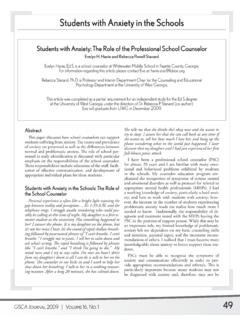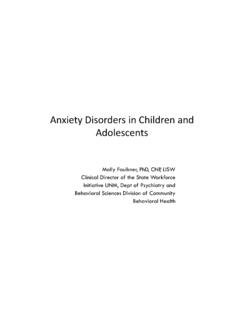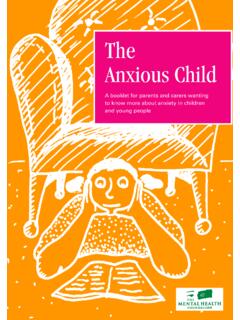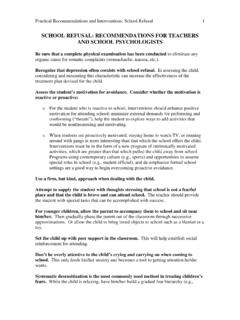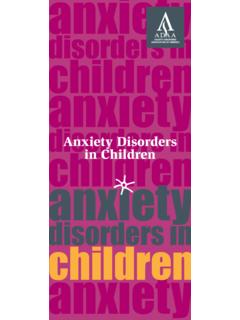Transcription of Intervention Strategies to Engage Students and Parents ...
1 Intervention Strategies to Engage Students and Parents Struggling with school anxiety school refusal Patrick McGrath Phd school anxiety / school refusal Program Alexian Brothers Behavioral Health Hospital Illinois school Code 105 ILCS 5/26-1) (from Ch. 122, par. 26-1) Sec. 26-1. Compulsory school age-Exemptions. Whoever has custody or control of any child between the ages of 7 and 17 years (unless the child has already graduated from high school ) shall cause such child to attend some public school in the district wherein the child resides the entire time it is in session during the regular school term, except as provided in Section , and during a required summer school program established under Section "Chronic or habitual truant" shall be defined as a child who is subject to compulsory school attendance and who is absent without valid cause from such attendance for 5% or more of the previous 180 regular attendance days.
2 Identifying a Student at Risk Absences from school Excessive excused and unexcused absences Increase in truancies Avoids portion of school day ( gym class, particular teacher{s} or period{s} of school ) Increase in somatic symptoms Exhibits stomach aches, headaches, nausea, vomiting, etc. especially on school days Frequent visits to doctors or specialized medical attention Identifying a Student at Risk (cont d) Change in grades or academic achievements Avoids or struggles to complete academic tasks Missing assignments or incomplete assignments Pattern of academic failure Decreased motivation associated with increased negative feelings towards school Easily overwhelmed with school and home expectations and/or assignments Identifying a Student at Risk (cont d)
3 Marked change in attitudes or behaviors Distressed about school more often than peers their age Feelings and attitudes towards school have negatively changed Behavior patterns only occur on school days Pattern of negative peer relationships Avoidance of school -related activities Difficulties with social skills and peer relationships Factors that Contribute to school refusal Difficulties Managing feelings of discomfort Experiencing disappointment Applying conflict resolution skills Communicating needs effectively to Parents , peers, and/or school staff When we are Uncomfortable or Anxious Our Fight or Flight system gets activated by the perception of threat/danger The perceived fear is greater than the actual threat/danger Everyday occurrences become overwhelming Behaviors interfere with daily functioning Maladaptive Coping (Avoidance)
4 Based on misappraisal of the threat Intention is to avoid fear stimulus or the danger it signals Coping patterns develop as a way to create immediate relief and avoid experience of discomfort Distress Tolerance Lack of crisis survival Strategies Underdeveloped skills to manage feelings such as disappointment, anger, and sadness Difficulty applying coping Strategies to stressors Emotional Regulation Difficulty managing emotions Lack of self soothing techniques Poor impulse control Functions of school refusal Behavior (Kearney)-4 Domains Domain 1: Avoidance of Negative Affect (somatic complaints, sadness, general anxiety ) Domain 2: Escape from Evaluative or Social Situations (social phobia, OCD perfectionism) Domain 3: Attention Seeking Behavior (separation anxiety , sympathy from family, high enmeshment) Domain 4: Pursuit of Tangible Reinforcers (video games, internet, sleep, drug use) Domain 1: Avoidance of Negative Affect Traits: anxiety symptoms, difficulty advocating for self, inability to self sooth Depressive symptoms, low tolerance for managing distress This student commonly presents with a lot of somatic complaints Domain 1: Avoidance of Negative Affect interventions .
5 Provide education about anxiety and effective response techniques Recognize patterns of behavior Teach ways to manage physical/somatic symptoms Develop anxiety /avoidance hierarchy and work on exposure situations Gradual re-exposure to school setting Domain 2: Escape from Evaluative or Social Situations Traits: Isolation and/or decrease of social activities Difficulty managing social situations Perfectionism/Fear of Failure Black and White Thinking Perseverates/obsesses on thoughts Domain 2: Escape from Evaluative or Social Situations interventions : Psycho-education anxiety /avoidance hierarchy Modeling and role-play Cognitive restructuring Gradual re-exposure to school setting anxiety Disorders are: Highly prevalent (most common class of mental disorder) Real & potentially disabling Found in all groups of people Under-recognized & under-treated Variable in presentation Treatable The Costs of anxiety Disorders Symptom distress and disability Medical and psychological complications Impact on family / Alienation 1/3 of indirect costs of mental illness due to anxiety What is anxiety ?
6 Normal, natural, built in through evolutionary processes Response to the perception of future threat or danger We need this to prepare for future potential difficulties Some anxiety is actually good for performance (Yerkees-Dobson) What is Panic? Normal, natural, built in through evolution Response to the perception of immediate threat or danger We need this to protect ourselves from danger Panic Continued Panic is our Fight or Flight response Natural selection selected out those that did not have this response system It is an alarm reaction Good in short bursts, problem if returns when there is no external cue for danger anxiety Disorders Our Fight or Flight system gets activated when it does not need to The fear is perceived but, by most standards.
7 Is far less than it is judged to be Everyday occurrences become overwhelming Behaviors interfere with daily functioning Cognitive Behavior Therapy for anxiety Disorders Correct misinformation and faulty threat appraisals Teach adaptive (nonavoidant) coping skills Contain maladaptive (avoidant) coping Facilitate exposure and readjustment to feared situations Teach relapse prevention PET Scans PET Scans Four Basic Fears Threats to the integrity of: *Physical Status *Mental Status *Social Status *Spiritual Status Common Distortions Severity It will be the worst thing in the world and I will die Probability It will definitely happen, no question Efficacy I will not be able to handle it Cognitive Behavioral Model for the Treatment of anxiety Disorders: Maintenance Fear Stimulus Misinterpretation of Threat anxiety Avoidant Coping Absence of Corrective Experience What maintains Stress?
8 Avoidance Reassurance seeking Distraction Rewards Short Term - People with anxiety want to feel good right now, so they do rituals to get that immediate good feeling, or they avoid what it is they are afraid of, or seek a great deal of reassurance. Long Term - In order to overcome anxiety , you need to practice being anxious right now so that you can learn that you can handle the anxiety . That anxiety will dissipate, therefore allowing you to feel better in the long run. Domain 3: Attention Seeking Behavior Traits: Seeks reassurance from parent Separation anxiety Poor boundaries/high enmeshment Parents may be overly sensitive and reactive to somatic complaints Domain 3: Attention Seeking Behavior interventions : Intense Parent training that includes: Structure and routine Clear expectations Altered use of language with child No options regarding school attendance Domain 4: Pursuit of Tangible Reinforcers Traits.
9 Poor sleep hygiene/patterns ( student stays up late and sleeps during the day Access to privileges without meeting expectations Lacks motivations to attend school Possible drug use and/or internet, gaming addiction Struggles with limits and resists authority Domain 4: Pursuit of Tangible Reinforcers interventions : Family based treatment Contingency contracting Communication skills Peer refusal skills training Holding child accountable Escorting child to class Rule out addictive disorders and seek alternative treatment when necessary Strategies and interventions Absence Policy Clear and enforceable attendance policies will help motivate Students Count all absences rather than differentiating between excused and unexcused Require a physician note for all absences Legal consequences Develop a relationship with truancy officers Communication Maintain consistent dialogue between school personnel and Parents on student s progress and expectations ( weekly contact with parent))
10 Creating rapport between student and staff helps the student to experience a connection with the school Strategies and interventions (cont d) school Wide interventions Peer helpers/call or contact from peer when absent from school Incentive program (gift card, etc) Automatic or personal phone call to student in the morning Encourage positive praise for accomplishments Establish connections with school staff/teachers Identify patterns of utilizing supports (limitation on time spent in social worker and/or nurse office ) Strategies and interventions (cont d) Hold Students and Parents accountable for attendance policy and truancy policy Screening in Middle school Provide accommodations in a supportive school environment Set clear expectations and follow through Academic failure may indicate the need for oPsychological/neuro-cognitive assessment oEmotional, behavioral, or academic accommodations Strategies and interventions (cont d) Classroom Assistance/Teacher interventions Have preplan Strategies with student that identify coping skills and supports that can be utilized in class Periodic check in with Students during class Organization of materials (color code notebooks, folders, etc)


